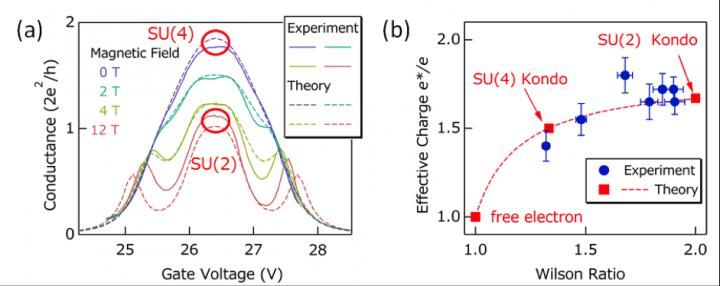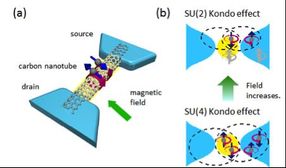Novel method to study quantum fluctuations in exotic phases of matter
We encounter phase transitions in our everyday lives when we witness water freezing or boiling. Similarly, quantum systems at a temperature of absolute zero also experience phase transitions. The pressure or magnetic field applied to such systems can be adjusted so that these systems arrive at a tipping point between two phases. At this point quantum fluctuations, rather than temperature fluctuations, drive these transitions.

(a) Spin and orbital degrees of freedom of electron in a carbon nanotube quantum dot is shown by the straight blue arrows and circle purple arrows, respectively. We can control the number of electrons in the quantum dot one by one by the nearby gate electrode (not shown in the figure). (b) Because of the spin and orbital degrees of freedom, an SU(4) Kondo state is formed at zero magnetic field as shown in the bottom panel. At high magnetic field it evolves continuously to an SU(2) Kondo effect (top panel).
Osaka University

(a) Conductance of the quantum dot as a function of the gate voltage. The conductance is normalized by the conductance quantum (2e2/h). The experimental data (solid lines) and the results of the numerical renormalization group (NRG) calculations (dashed lines) are quantitatively consistent with each other. (b) Filled circles show the effective charge e*/e as a function of Wilson ratio which quantifies the strength of fluctuations. The effective charge e*/e is derived by the current noise and the Wilson ratio represents quantum fluctuations. Three square symbols represent the theoretical prediction for SU(4), SU(2), and non-interacting particles. Dashed line is the extended theoretical prediction, which nicely connects the symmetry crossover of the quantum liquid ground states.
Osaka University


Many fascinating phenomena with promising technological applications in areas such as superconductivity are linked to quantum phase transitions, but the role of quantum fluctuations in such transitions remains unclear. While there have been many advances in understanding the behavior of individual particles such as protons, neutrons, and photons, the challenge of understanding systems containing many particles that strongly interact with one another has yet to be solved.
Now, an international research team led by a group at Osaka University has discovered a clear link between quantum fluctuations and the effective charge of current-carrying particles. This discovery will help researchers uncover how quantum fluctuations govern systems in which many particles interact. One example of such a system is the interaction of electrons at extremely low temperatures. While low temperatures normally cause the resistance in a metal to drop, the resistance rises again at extremely low temperatures due to small magnetic impurities--this is referred to as the Kondo effect.
"We used a magnetic field to tune the Kondo state in a carbon nanotube, ensuring that the quantum fluctuations were the only variable in the system," study coauthor Kensuke Kobayashi says. "By directly monitoring the conductance and shot noise of the carbon nanotube, we were able to demonstrate a continuous crossover between Kondo states with different symmetries."
Using this novel approach, the researchers discovered a link between quantum fluctuations and the effective charge of current-carrying particles, e*. The discovery means that measurements of e* can be used to quantify quantum fluctuations.
"This is very exciting, as it paves the way for future investigations into the exact role of quantum fluctuations in quantum phase transitions," explains Professor Kobayashi. Understanding quantum phase transitions has the potential to enable many interesting applications in areas such as superconductivity, Mott insulators, and the fractional quantum Hall effect.
Original publication
Original publication
Meydi Ferrier, Tomonori Arakawa, Tokuro Hata, Ryo Fujiwara, Raphaëlle Delagrange, Richard Deblock, Yoshimichi Teratani, Rui Sakano, Akira Oguri, and Kensuke Kobayashi; "Quantum Fluctuations along Symmetry Crossover in a Kondo-Correlated Quantum Dot"; Phys. Rev. Lett; 2017
Topics
Organizations
Other news from the department science

Get the chemical industry in your inbox
By submitting this form you agree that LUMITOS AG will send you the newsletter(s) selected above by email. Your data will not be passed on to third parties. Your data will be stored and processed in accordance with our data protection regulations. LUMITOS may contact you by email for the purpose of advertising or market and opinion surveys. You can revoke your consent at any time without giving reasons to LUMITOS AG, Ernst-Augustin-Str. 2, 12489 Berlin, Germany or by e-mail at revoke@lumitos.com with effect for the future. In addition, each email contains a link to unsubscribe from the corresponding newsletter.



























































